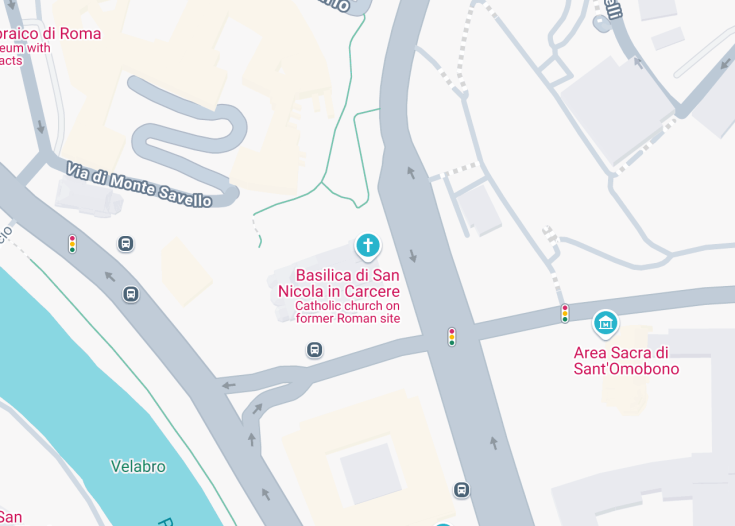Situated in the heart of Rome, the Basilica di San Nicola in Carcere is a remarkable example of medieval architecture intertwined with ancient history. Constructed atop the ruins of three Roman temples, this basilica offers visitors a unique glimpse into the city’s rich spiritual and cultural heritage, featuring structural remnants that date back to the Republican era. Its exquisite artworks and serene ambiance make it a must-visit for both pilgrims and tourists alike.
Visitors are encouraged to explore the Basilica di San Nicola in Carcere during off-peak hours to fully appreciate its tranquil atmosphere and artistic details. Early mornings or late afternoons often provide the best opportunity for contemplation and reflection.
When planning your visit, consider attending a mass to experience the basilica’s spiritual resonance. Engaging with the local community during these services can enhance your understanding of the historical and cultural significance of this sacred site.
Basilica di San Nicola in Carcere in Rome (Rome), Italy
The Basilica di San Nicola in Carcere exhibits a blend of medieval architectural style and significant historical remnants, reflecting its origins rooted in the ancient past. This church, predominantly built over the ruins of three esteemed temples dedicated to Juno Sospita, Janus, and Spes, showcases elements such as a trabeation evident in its structural layout. The incorporation of spolia, including ancient columns, into its facades not only accentuates its historical significance but also highlights the resourcefulness of early builders in repurposing historical materials.
Originally constructed in the 6th century, its name “in carcere” emerges from its proximity to a prison that became falsely associated with the notorious Tullianum. Over the centuries, the basilica has undergone several restorations, notably in 1599 by Giacomo della Porta, who rejuvenated its façade while maintaining the historical campanile, originally a fortified tower. The interior is richly adorned with works by prominent artists, enhancing its status as an artistic focal point within Rome’s ecclesiastical landscape.
History
3rd to 2nd Century BC
During the Roman Republic, three significant temples were established in the Foro Olitorio. These temples, dedicated to Juno Sospita, Janus, and Spes, formed an integral part of the area’s religious architecture. Their structural remnants can still be observed within the church today, with columns from the Temple of Juno Sospita embedded into the church’s walls.
6th Century
The first ecclesiastical structure in this area dates back to the 6th century, signifying the adaptation of ancient Roman sites for Christian worship. An inscription from the 10th century and evidence of early Christian architecture validates the church’s historical continuity. The church’s unique designation stems from its connection to a nearby prison, misidentified as the Tullianum.
11th Century
By the 11th century, the church gained the name “Petrus Leonis,” after the influential Pierleoni family. This period highlighted urban transformations, with the church being reconstructed through both fortification and aesthetic enhancements. The medieval features were preserved while adapting to the shifting needs of the community around it.
16th to 19th Century
The basilica witnessed significant restoration in 1599, led by architect Giacomo della Porta, who modified the façade and maintained the existing campanile. This rebuilding endeavor marked a renaissance for the church, preserving its historical essence while adapting it for continued use. The basilica was completed in its current form in 1865, reflecting a balance between innovative design and historical fidelity.
Experiences at Basilica di San Nicola in Carcere in Rome
Visitors can explore the splendid interior adorned with remarkable works of art, including frescoes by notable artists like Giovanni Baglione and Guercino. The basilica, with its unique blend of historical and artistic elements, invites contemplation and reverence. Moreover, the underground area providing glimpses of ancient temple structures offers a fascinating insight into the layers of history encompassed within.
Cultural significance of the community
Historically, the Basilica di San Nicola in Carcere has served as a spiritual hub for the local community, especially for the Greek community that revered Saint Nicholas. This dedication reflects broader cultural traditions, showcasing the multicultural nature of Rome. The ongoing veneration of various saints, including representations of the Virgin Mary, underlines the rich tapestry of faith practices that have evolved around this sacred space.
General informations
Location
The Basilica di San Nicola in Carcere is located in the historic center of Rome, within the rione Sant’Angelo. It’s situated near several notable landmarks, including the Theatre of Marcellus and the Tiber River, making it easily accessible to visitors.
Address:
Via del Teatro di Marcello, 46, 00186 Roma RM, ItalyVisiting Information
The Basilica di San Nicola in Carcere is open to the public. Visitors can freely explore the basilica and its historical features throughout the day. For a serene experience, it is recommended to visit in the morning or late afternoon, when crowds tend to be smaller.
How to reach the destination
Car
The Basilica di San Nicola in Carcere can be reached by car, with available parking structures nearby for a nominal fee. There are also several public parking lots within walking distance.
| Route | Distance | Travel time |
|---|---|---|
| From Rome Fiumicino Airport | 30 km (18.5 miles) | 45 minutes |
| From the Colosseum | 2 km (1.2 miles) | 10 minutes |
| From Vatican City | 4 km (2.5 miles) | 15 minutes |
Public Transport
Visitors can also reach the Basilica via public transportation. The nearest metro station is Circo Massimo, followed by a short walk to the church.
| Departure Point | Travel time |
|---|---|
| From Rome Fiumicino Airport (via train) | 1 hour |
| From the Colosseum (via bus) | 15-20 minutes |
| From Vatican City (via bus or tram) | 25-30 minutes |
Accessibility and Limitations
The Basilica di San Nicola in Carcere has limited accessibility due to its historical structure. Visitors with mobility impairments may find it challenging to navigate certain areas within the basilica.
Accessibility
Limitations
- Limited space for wheelchair maneuverability inside the church.
- Some areas may have uneven flooring, posing a risk for visitors with mobility issues.
- Visiting hours may vary for religious services or events, which could restrict access at certain times.
Notes to visitors
- Photography inside the church may be limited; always check for signage.
- It’s advisable to maintain a quiet atmosphere, especially during worship times.
- Visitors should dress modestly when attending services.
Common questions
What are the notable artworks inside Basilica di San Nicola in Carcere?
The Basilica di San Nicola in Carcere houses a wealth of notable artworks that reflect its rich history and artistic significance. Among these, you can find:
-
Affreschi by Giovanni Baglione in the Aldobrandini Chapel, showcasing intricate religious themes and vibrant colors.
-
The ‘Trinità ed Angeli’ by Giovanni Francesco Barbieri, also known as Guercino, which adds to the spiritual ambiance of the church.
-
A beautiful depiction of ‘Madonna con Bambino’ created by Antonio di Benedetto Aquili, dating back to 1470, emphasizing the Virgin Mary’s significance in Christian art.
-
‘Ascensione di Cristo’ by Lorenzo Costa, a striking altarpiece from around 1500-1510 that captures the moment of Christ’s ascension.
-
Various artworks by renowned artists such as Cristopher Hewetson, Federico Fiori (Barocci), Guido Guidi, and Orazio Gentileschi, each contributing to the church’s cultural tapestry.
These works not only illustrate the artistic evolution over centuries but also enhance the church’s role as a spiritual and cultural landmark in Rome.
What architectural features stand out at Basilica di San Nicola in Carcere?
The architectural features of the Basilica di San Nicola in Carcere are fascinating and highlight its historical significance. Key features include:
-
The facade designed by Giacomo della Porta, which exemplifies late Renaissance architectural style blended beautifully with medieval elements.
-
The preservation of the medieval campanile, originally a fortified tower, which adds a unique charm to the overall structure.
-
Integration of ancient Roman temple ruins within the church’s design, notably the three temples from the Republican era that give insight into Rome’s architectural evolution.
-
The interior layout featuring lovely chapels and a prominent altar, showcasing intricate detailing and art that narrates biblical stories.
-
Beautifully crafted stained glass windows that allow light to filter through in an enchanting manner, further enhancing the spiritual atmosphere.
Overall, the combination of these elements creates a captivating sight for visitors and demonstrates the ability of the Basilica to serve as a place of worship while honoring its ancient roots.
Is there a significance to the name 'in Carcere' associated with the Basilica?
The name ‘in Carcere’, which translates to ‘in prison’, has historical significance related to the location of the Basilica di San Nicola in Carcere. This title derives from a tradition that links the site to a prison that was believed to be associated with St. Peter during early Christian times. Although modern scholarship suggests that the site housed a Byzantine-era prison known as ‘Carcer ad Elephantum’, the name persists as a nod to the area’s historical narrative.
Furthermore, the church is believed to have been built atop the ruins of ancient Roman temples dedicated to various deities, including Juno Sospita, Janus, and Spes. This historical richness allows visitors to explore layers of significance, from ancient Roman worship to early Christian worship and the medieval renovations. Today, the term ‘in Carcere’ embodies both the spiritual and historical dimensions of the Basilica, reminding visitors of the convergence of faith and history present in this iconic site.
What role does Basilica di San Nicola in Carcere play in the local community?
Basilica di San Nicola in Carcere plays a multifaceted role in the local community in Rome, reflecting both spiritual and cultural dimensions. As a Catholic place of worship, it serves as a focal point for local religious activities, including regular Mass, special feasts dedicated to saints, and community services. The church is particularly significant for the Greek community in Rome, who venerate St. Nicholas, making their cultural heritage an integral part of the church’s identity.
Moreover, the Basilica functions as a cultural hub, hosting art exhibits and music performances that highlight the rich artistic heritage of the area. Its beautiful interior and historical significance attract both local residents and tourists, fostering a sense of community and shared history. Events commemorating Marian devotion, particularly in relation to Our Lady of Guadalupe and Our Lady of Pompeii, further enhance its role in fostering a sense of belonging and religious connection among its parishioners.
Lastly, the Basilica’s participation in wider diocesan initiatives emphasizes its commitment to social outreach, catering to the needs of the less fortunate and striving to make a positive impact in the community.

Is the Basilica di San Nicola in Carcere in Rome worth visiting?
The Basilica di San Nicola in Carcere is certainly worth visiting for those interested in history and architecture. This unique church, built atop the ruins of ancient temples, showcases a fascinating blend of medieval architecture and Roman relics. Visitors can marvel at remnants of the Foro Olitorio, including three ancient temple foundations that lie beneath the basilica. The presence of spolia, especially the columns from the Temple of Giunone Sospita, adds a rich layer to its historical significance. Moreover, its secluded location provides a tranquil experience away from the usual tourist crowds. The frescoes, exquisite altarpieces, and the church’s atmospheric ambiance make it a delightful stop for anyone exploring the charming streets of Rome. Overall, this basilica offers a unique perspective on Rome’s layered history and cultural heritage.










